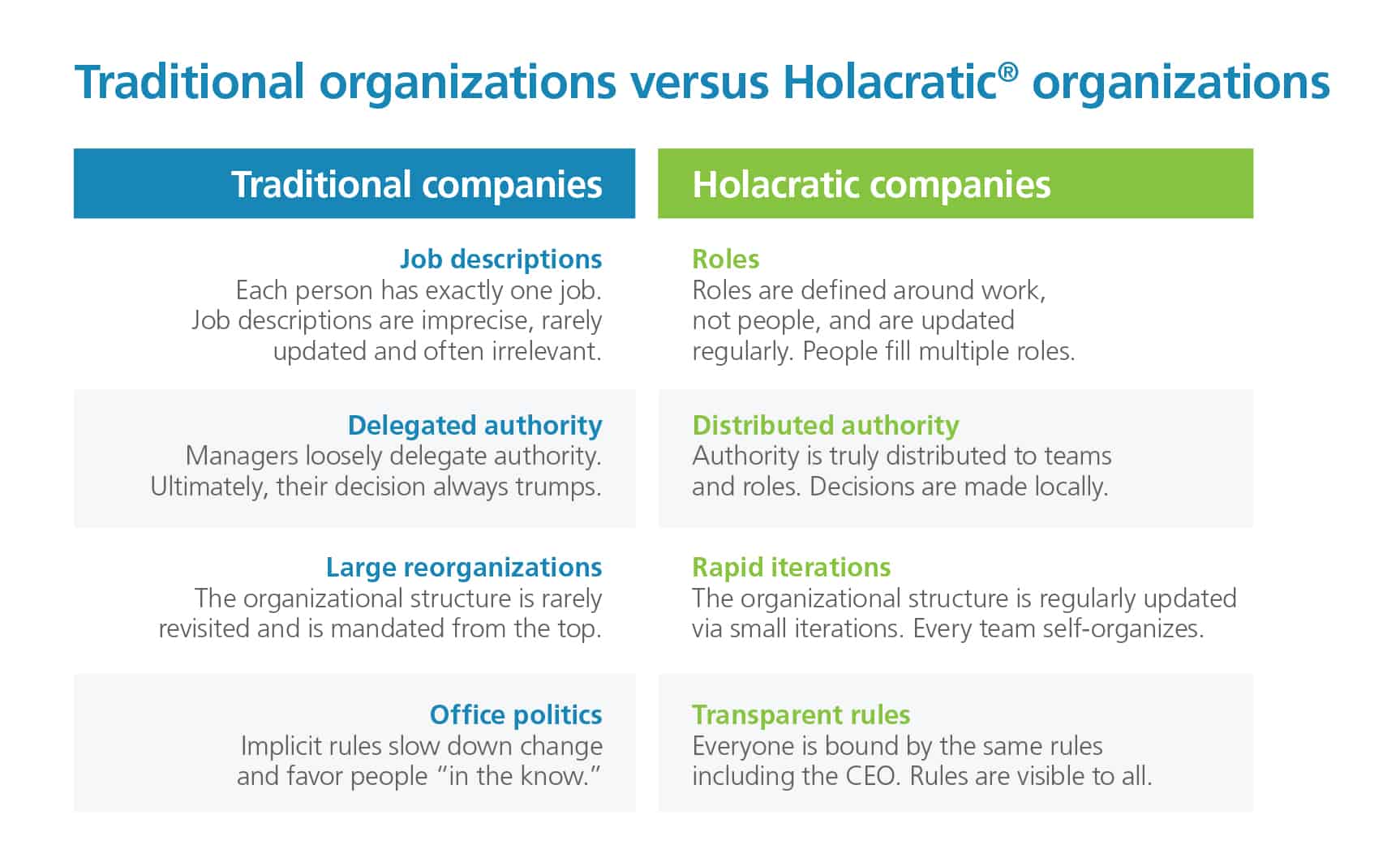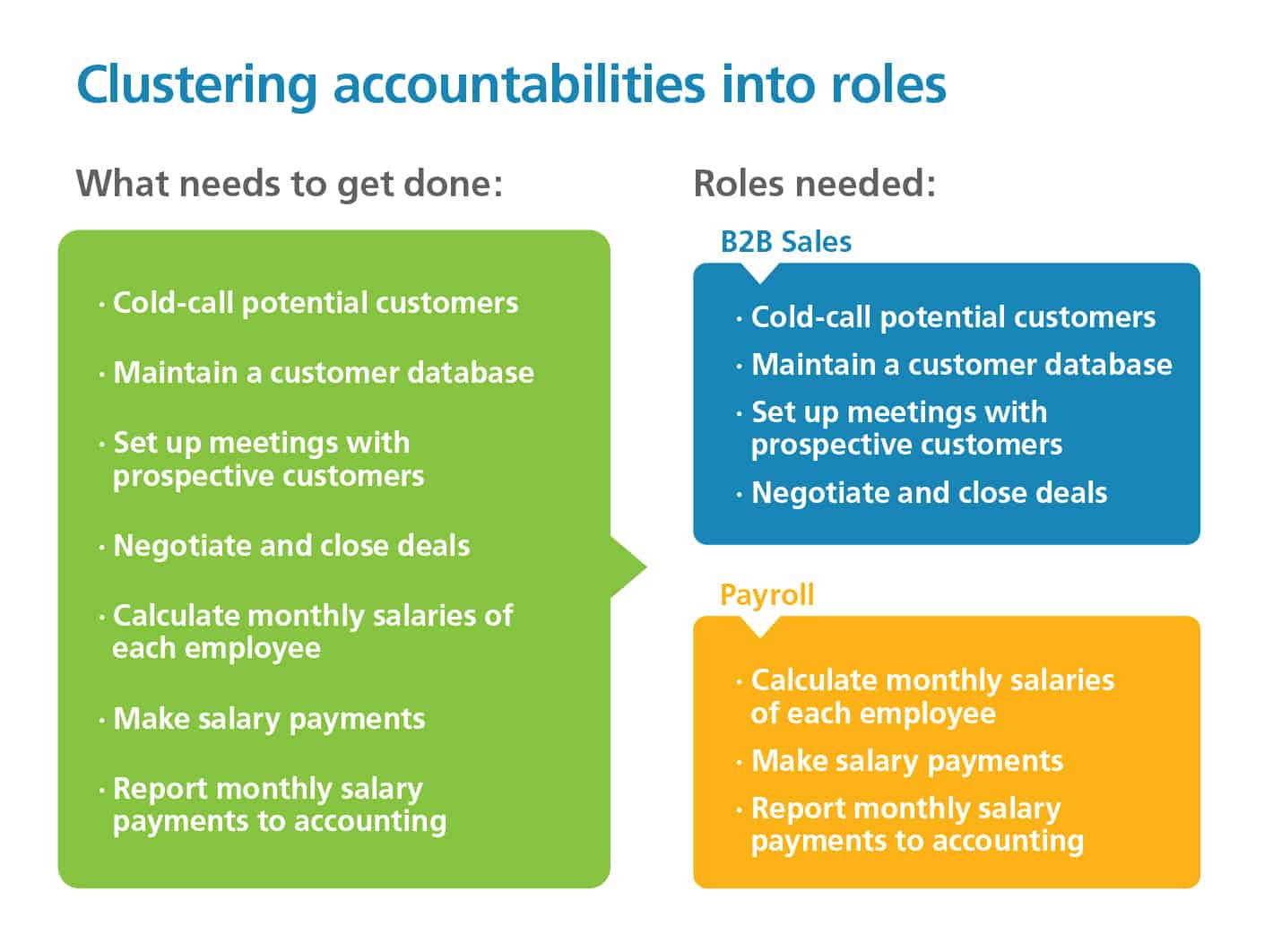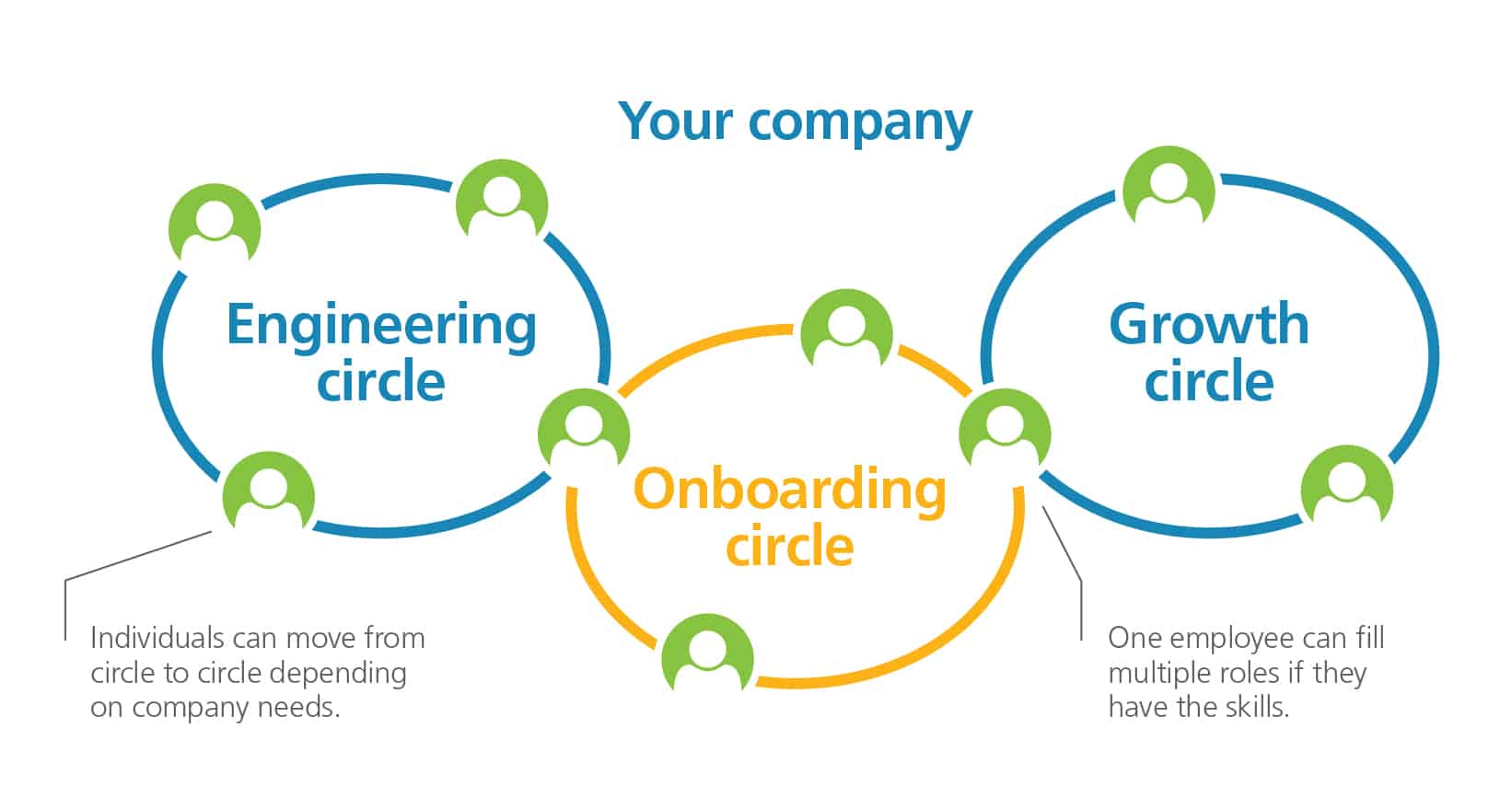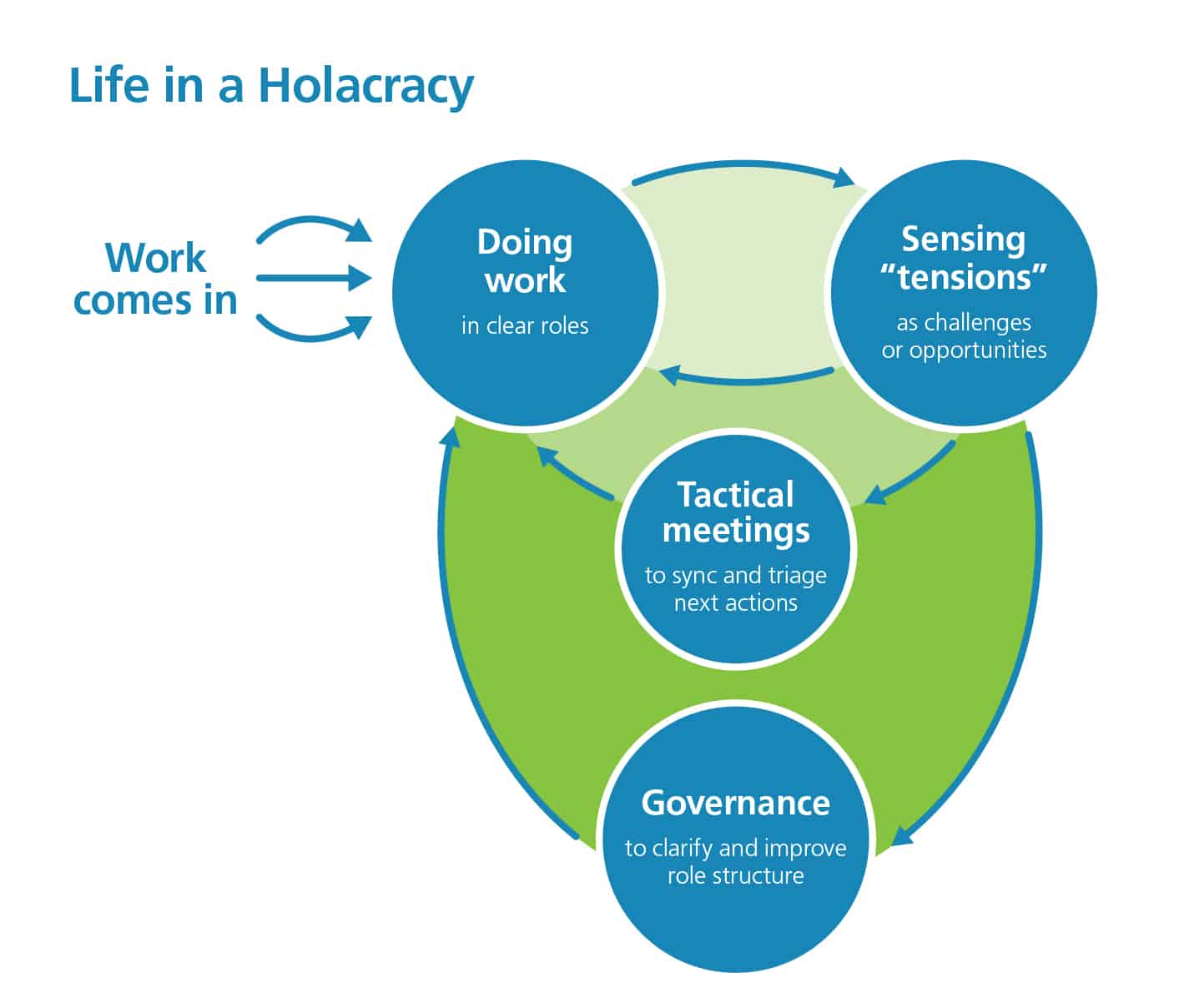An empowering management model—without managers
So long, managers! Hello, Holacracy!
Holacracy is a new way of running an organization. The Holacratic model removes power from the typical top-down management hierarchy and distributes it to the team members doing the work.[1]
Holacracy was developed to increase responsiveness, remove obstacles and create clarity.[2],[3] Holacratic companies organize around the work instead of the people who do the work. Titles aren’t important—but getting stuff done is!
This Blue Paper will explore the emergence of Holacracy, how it works, why it’s a challenging management model and best practices for adopting (or adapting) the practice.
Getting to know Holacracy
Holacracy has gained visibility thanks to famous practitioner Zappos®, the online shoe retailer. With 1,500 employees, Zappos announced in November 2013 that it was shifting to a Holacracy and, to date, is the largest company to do so.[4] Besides Zappos, about 300 organizations use Holacracy, including the Washington state government.[5] So far, outcomes from adopting Holacracy have been anecdotal, but basically all organizations that make the shift expect to gain efficiency and drive productivity.
Zappos adopted a Holacratic framework to prevent the company from “becoming too rigid, too unwieldy and too bureaucratic as it grows.”[6] In other words, leaders saw that bureaucracy was getting in the way of adaptability.
Holacracy as a term and practice was developed by software entrepreneur Brian Robertson, who had interest in how people work together. In 2007, Robertson co-founded HolacracyOne, which helps organizations implement Holacracy. (HolacracyOne holds the registered trademark for Holacracy.)[7],[8]
Holacratic companies may be a fringe trend, but there’s definitely movement toward simplification. Agile models with lean processes show up at Google®, Amazon.com® (which is Zappos’ parent company), Uber™ and Spotify®.[9] The speed of business today inspires these new, speedy practices.
A Holacratic practice may accelerate decisions and productivity. But, it’s not easy to adopt and takes widespread commitment. Some employees balk at Holacracy, as Zappos has found. To get all its people on board with Holacracy, Zappos gave employees an ultimatum in March 2015: Embrace the strategy or take a buyout. As of January 2016, about 18 percent of employees so far have taken the buyout.[10] It’s a challenging shift that demands vigorous participation.
In spite of that, Zappos leader Tony Hsieh says he wishes he would have switched to a Holacracy sooner. One benefit so far is that the organization’s 20 percent turnover is “well below” most other call centers, Hsieh said. Holacracy has helped Zappos “maximize the number of employees that believe in the company mission, are passionate about customer service and believe that this is the right culture for them.”[11] In short, Holacracy helped Zappos keep truly dedicated team members.
Holacracy vs. traditional management
Comparing Holacracy to traditional management drives understanding of the nontraditional model. The most common operating model is command and control (C&C). C&C is a hierarchy, where decisions come from the top and “action lives at the bottom.”[12] It’s all about your boss—and your boss’s boss (and it goes up the chain of command from there).
In a traditional hierarchy, team members work within their title and department.[13] But, when people can’t incite change, they often protect their turf and disengage.[14] The organization suffers.
To compare, in a Holacracy, team members take on roles that match their skillset and company demands.[15] They don’t convince someone else (e.g., a boss) to act. They have authority to act on their own.[16]
Figure 1 below breaks down the differences between a traditional organization and a Holacratic organization:[17]

Figure 1: Traditional organizations versus Holocratic organizations[18]
Traditional organization versus Holacratic® organizations
Traditional companies
- Job descriptions. Each person has exactly one job. Job descriptions are imprecise, rarely updated and often irrelevant
- Delegated authority. Managers loosely delegate authority. Ultimately, their decisions always trumps
- Large reorganizations. The organizational structure is rarely revisited and is mandated from the top
- Office politics. Implicit rules slow down change and favor people “in the know”
Holacratic® companies
- Roles. Roles are defined around work, not people, and are updated regularly. People fill multiple roles.
- Distributed authority. Authority is truly distributed to teams and roles. Decisions are made locally.
- Rapid iterations. The organizational structure is regularly updated via small iterations. Every team self-organizes.
- Transparent rules. Everyone is bound by the same rules including the CEO. Rules are visible to all.
How Holacracy works
Holacracy is more than getting rid of managers (although that’s part of the model). Here’s a look at the principles of Holacracy:[19],[20],[21],[22],[23],[24],[25]
Work is aligned with roles
Roles are aligned with areas of expertise. One-to-one identification with your title doesn’t exist. For example, instead of saying, “I am a marketing associate, and I am responsible for X,” team members have multiple roles on multiple teams. Roles are works in progress. They are constantly updated by the teams tackling the projects so that roles have authority, rather than people.
In a Holacracy, all the actions critical to success—accountabilities—are laid out. Then, roles are created by grouping accountabilities. Here’s an example of how roles are developed in Figure 2:[26]

Figure 2: How roles are developed in a Holacracy[27]
Clustering accountabilities into roles
What needs to get done:
- Cold-call potential customers
- Maintain a customer database
- Set up meetings with prospective customers
- Negotiate and close deals
- Calculate monthly salaries of each employee
- Make salary payments
- Report monthly salary payments to accounting
Roles needed in B2B sales:
- Cold-call potential customers
- Maintain a customer database
- Set up meetings with prospective customers
- Negotiate and close deals
Roles needed in payroll:
- Calculate monthly salaries of each employee
- Make salary payments
- Report monthly salary payments to accounting
Roles are the backbone of a Holacratic organization. They help create value because:[28]
- Team members can use all of their skills. They’re not locked into a title.
- The organization may not need to add new staff to get work done. The people who already deeply understand the business have everything covered.
- They encourage creativity, which drives productivity.
- Stuff gets done effectively because skillsets are appropriately matched.
- People feel like they’re working as a team (vs. inside silos).
Networks outrank hierarchies
Teams as we know them don’t exist in a Holacracy. Instead, people work within circles (Figure 3):[29]
For example, a group of people may work in the “engineering circle,” the “onboarding circle” and the “growth circle.” Individuals can move from circle to circle depending on company needs and one employee can fill multiple roles if they have the skills.

Figure 3: Holocracies have circles, not teams[30]
While it’s true Holacracies don’t have managers, each circle has a lead link who assigns people to roles. The lead link can define work priorities and strategies, but they cannot tell people what to do. Functions may be delegated away from a lead link, but no additional functions may be added to the role.
Team members are autonomous
Leadership is distributed throughout the company, and meetings give team members authority to move forward without say-so from a higher-ranking team member. Everyone becomes an entrepreneur in his or her role. The goal is serving the purpose and customer. In a self-managing environment, lead links balance trusting their team with driving accountability.
Use meetings for rapid iteration
Meetings help guide work toward incremental improvements. The meetings follow strict rules where everyone has a voice, but there’s no call for consensus.
Self-organizing teams hold two types of meetings: tactical and governance. Tactical meetings are for a triage of work. Governance meetings, usually held monthly, determine revisions to roles and processes to reflect changing team conditions. Governance meetings may change functions for lead links. Incremental steps—versus a massive reorg in a traditional organization—shift who owns what work.
Below is a visual representation of life in a Holacracy (Figure 4):[31]
Life in a Holacracy
When work comes in, people have clear roles to do that work. “Tensions” are sensed as challenges or opportunities within that work, and tactical meetings are held to sync and triage the next best actions based on those “tensions.” Governance meetings are the overall meetings meant to clarify and improve role structure in the organization as a whole.

Figure 4: Life in a Holacracy[32]
In a Holacracy, proposals are safe to try. Anyone can make, or change, a proposal at any time. The high frequency of proposals means there’s less pressure for perfection. As long as a proposal is safe to try—i.e., it will help collect valuable data—it’s a go. Proposals are rejected only if the circle doesn’t have domain or if there’s proof one could harm the organization before it could be mitigated. In the safe-to-try framework, “you can’t simply object because you don’t like an idea or have a better one. Even if you make more mistakes this way, you’ll learn and course correct faster.”
Document everything for the sake of transparency
Authority lives in the process. It’s documented in a Holacratic constitution, not a top leader. A written document lays out ownership, decision-making and accountability. The constitution identifies “who will act as lead link from the individual or group ratifying the constitution.” The lead link in the constitution-ratifying “anchor circle” is responsible for designating lead links for sub-circles. And, those sub-circle lead links designate lead links for their sub-circles.
A documentation system helps record rules, changes over time and lessons learned. This transparency empowers team members by providing context. Organizations may employ a wiki or other intranet-based solution to aid in adoption, record keeping and ongoing practice of Holacracy. Transparent communication tools—for a price—also exist.
So, what does Holacracy look like in action? And, can it help make money? Consider the case of Blinkist®, which produces summaries of nonfiction books you can read in an app. Customers kept asking for audio versions of the summaries. To enable the creation of audio versions, Blinkist shifted from a complex C&C model to a nimble Holacracy, getting rid of titles and signing up everyone with roles. The switch allowed a more multidisciplinary approach to completing the work, which wasn’t possible in the old organizational structure. Thanks to the Holacracy, the audio project was ready for customers in just two months, and since its launch, audio has been the biggest driver of the threefold monthly revenue increase.[33] Holacracy is a new practice, but it’s creating value for some organizations.
Why Holacracy is hard
Even if you think Holacracy—or elements of it—could work for your organization, the practice is challenging. Here’s why:[34],[35],[36],[37],[38]
Command and control is the norm. People are used to hierarchies, and they like them. “Show me any group of five human beings or five apes or five dogs,” said author and Stanford University business professor Bob Sutton. “And I want to see the one where a status difference does not emerge. It’s who we are as creatures.” The problem with Holacracy is that most people only have worked in C&C environments. At first, it feels wrong, and there’s a strong urge to fall back into the C&C mind-set.
There’s a learning curve. And, because hierarchies are the norm, it takes time and commitment to get the hang of self-management and self-organization. In self-management, a team member decides how to work on her own. In self-organization, team members work together as a group to “form, evolve and disband.” Team members are not hired to fill a job description, but instead to discover where they can create the most value.
Holacracy is rigid. Each organization has a unique culture with unique norms. However, the Holacratic framework, as established by HolacracyOne, is rigid and may need to be adapted to feel more natural. There’s new jargon and a process that shakes up everything you know about working on a team.
Holacracy fights the human factor. Holacracy isn’t human centered; it’s process centered. In Holacratic meetings, team members explore tensions in the work at hand. If you’re a new employee, this forum can be a strange place to ask for feedback and guidance. Hiring in a Holacracy also is challenging. For example, the hiring process at Valve, a Washington-based software company that practices Holacracy, is by employee consensus, which is “extremely difficult,” according to founding member Greg Coomer. “We’ve demanded of ourselves that we’d never hire someone who we wouldn’t want to be our boss, at the highest and lowest levels.”
Holacracy isn’t impossible, but it’s not a turnkey solution. The efficiencies a Holacracy can introduce may be worth a challenging implementation.
How to make Holacracy work for your organization
In a Holacracy, “people bring themselves more fully to the organization instead of just their professional selves.” Many additional benefits to adopting a Holacracy exist:[39]
- Increased personal responsibility
- Distributed decision-making
- Boosted productivity
- More accountability
- Decreased bureaucracy
- Increased creativity and collaboration
What’s more, Holacracy eliminates the shortcomings of traditional hierarchy, including:[40]
- The growing cost of adding managers (who earn more than their subordinates) as you add employees
- The danger of uncontestable decision-making that rests with top leadership
- The slow pace of decision-making as it passes through levels of hierarchy
- How low-level employees are disempowered, shrinking their incentive to “dream, imagine and contribute.”
If the benefits of Holacracy have piqued your interest and you’re ready to test Holacracy for yourself, keep these best practices in mind, whether you’re going all in or shopping al la carte:[41],[42],[43]
First, master self-management. Self-management doesn’t come easy for everyone, so be gentle. “Make your own decisions!” isn’t the right way to communicate with every team member. If one person struggles, the entire team struggles. To maximize productivity in an environment of self-managers, match people and work. When people and work don’t jell, help them find a better path.
Put your own spin on it. If you’re using Holacracy (or elements of it), examine how the practice falls short in your organization and come up with your own simple, flexible and custom solution to bridge those gaps. Your people will be happier for it! To ensure humanity isn’t lost in a Holacracy, tell the true stories—good, bad and ugly—of how the model has evolved in your organization. Management models impact people, and people want to relate to and learn from other people.
Strive to reduce complexity.
- Bust up bottlenecks. Team members make decisions. Lead links should stay out of work unless it’s a decision that’s under their authority or a teammate is looking for advice.
- Give away authority. Hand off work if you’re not skilled at it, you’re not passionate about it, a teammate is better suited for it or you don’t have time for it.
- Stay on task. The health of the team and its ability to create value depends on defining the work, allocating resources and establishing metrics for success. Shut down distractions.
Keep communicating.
- Be transparent. Install a system that lets your team know expectations from work as they evolve, who has authority and what rules must be followed in your Holacratic environment.
- Drive accountability. When someone says they’ve got it, follow up early and often to make sure the commitment is on track.
- Give constructive feedback. Share what you like about an idea. Then, offer suggestions for how to make it even better.
- Set an example. Be self-aware of your actions, seek feedback on your own work and work shoulder-to-shoulder to understand hardships and opportunities. Behavior is contagious across a team.
Know if you’re a good fit for Holacracy. Holacracy seems to complement certain types of organizations. Tech companies, including Washington-based software company Valve and Japanese gaming developer Kayac, have done well with flat organizations. According to Ethan Bernstein, assistant professor at Harvard Business School, “Coders seemingly understand this sort of system better than non-coders.” In a Holacracy, team members are “T” shaped—they “have deep expertise and are also laterally obsessed.”
Elements of Holacracy could fire up value creation and inspire culture change at your organization. Adapt the Holacratic “safe to try” mind-set if you’re curious!
Shaking things up with Holacracy
You don’t have to fully adopt Holacracy to gain benefits. Even in small doses, this management method is guaranteed to shake up any team that takes it on. A fresh perspective brought about by Holacracy can help you identify new opportunities. In fact, the leading practitioners of Holacracy encourage taking a “test drive” to know whether the model could work for your organization.[44] The good news is it’s not an all-or-nothing practice. The bad news is it’s not easy to break free from traditional management.
While Holacracy in its purest form might not fly for all firms, its principles of transparency, accountability and responsiveness are critical to every 21st century organization. Knowing what you need to do—and doing it well—always will contribute to success.
Page 1 of 2
